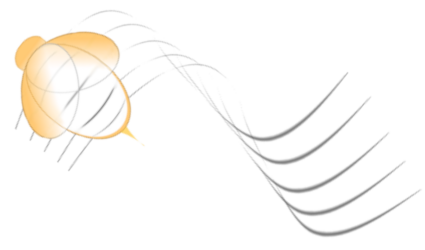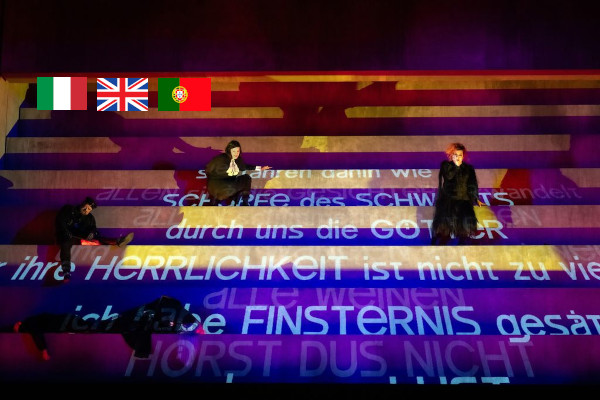Constant tension
by Fabiana Crepaldi
Baden Baden 26th March 2024 If the tragedy Elektra was originally very Greek, the 1909 opera that marked the debut of the fruitful partnership between Richard Strauss (1864-1949) and Hugo von Hofmannsthal (1874-1929) is very Austrian. Although the action of the opera also takes place in Mycenae and there is a rough correspondence between the scenes in Hofmannsthal's Elektra and Sophocles' Elektra, the situations are distinct and the dialogues are significantly different. In his Elektra, which premiered as a play in 1903, Hofmannsthal transports Sophocles' work to the crises of Viennese patriarcal Society in the fin-de-siècle: a Society marked by growing misogyny and the beginnings of psychoanalysis..
In his interesting article Fin-de-siecle fantasies: Elektra, Degeneration and Sexual Science (Cambridge Opera Journal, 1993), Lawrence Kramer points out that there is a double reading in Elektra, which for him “represents a complex negotiation with the misogyny of supremacist culture. By privileging Elektra's subjectivity, Strauss goes against the supremacist grain that denies women legitimacy (...) as individual subjects. Yet his characterisation of Elektra reproduces all the atavistic traits - animalism, uncleanliness, sensual cruelty, erotic perversity, amorality, automatism - routinely ascribed to women in justifying that denial.”
As for the echoes of psychoanalysis, it is interesting to note that the character of Hofmannsthal's Elektra is different from that of Sophocles. In the Greek tragedy, Elektra seeks revenge for her father's death so that justice can be done and the family can be freed from the crime committed by her mother. In Hofmannsthal, she is obsessed with the idea of avenging the death of her father, Agamemnon, and killing his murderers: Clytemnestra, her mother, and Aegisthus. In Hofmannsthal's Elektra, you can recognise clinical cases discussed by Sigmund Freud and Joseph Breuer in Studies on Hysteria (1893), which was part of Hofmannsthal's library.
The dialogue between Elektra and her mother, Clytemnestra, is a genuine psychoanalysis session. At first, Clytemnestra goes to Elektra like someone going to the psychiatrist. "She talks like a doctor," remarks the mother when she decides to go and talk to her daughter. Clitemnestra has her traumas and blocks - "That sounds so familiar. It's simply as if I'd forgotten about it a long, long time ago." In her meetings with Elektra, she goes in search of a way to end her nightmares, such as being strangled by Orestes.
In Sophocles, the situation is quite different. Clytemnestra dreamt that Agamemnon had risen from the dead. In her dialogue with Elektra, she doesn't even mention the dream. There is no trauma or sense of guilt. The Greek Clytemnestra defends herself: she killed Agamemnon in revenge for his having offered one of the couple's daughters, Iphigenia, as a sacrifice so that he could help his brother Menelaus in Troy. This justification isn't even mentioned in the opera, where Clytemnestra's guilt is unquestionable.
At the Festspielhaus in Baden-Baden, stage directors Philipp Stölzl (who was also responsible for the set design and lighting) and Philipp M. Krenn created a functional and abstract setting to move the plot from classical Greece to the psychoanalytic environment. Or, as Stölzl wrote in the programme, they opted for "a focused solution, which directs a magnifying glass at the characters and their feelings".
Oppressive, dangerous, precipitous, the set consisted of a huge staircase with large, mobile steps. The displacement of these steps allowed the staircase to be transformed into a wall, or into different environments that vertically separated and confined the characters, or into oppressive environments that didn't allow the singers to stand. This oppressive, crushing ceiling was used, for example, when Elektra received the news of Orestes' death and in her second duet with Chrysostemis. Whatever the setting, however, tension and danger were always present - everyone was literally on the edge of a cliff and any false step could be fatal. "Every move on it can be risky - the unsettling nature of this steep stage is part of the concept," explains Stölzl.
In addition to the imminent danger, the directors emphasised the value of the text and its literary background by projecting the libretto onto the set. "'Elektra' was not written for opera.Hofmannstahl wrote the piece for the spoken stage - there are dialogues, monologues, but not the classic aria, 'stretta' or duet as in opera.The structure has many references to Greek tragedy, to the very origins of theatre. (...) We thought it was worth experimenting with whether Hofmannsthal's incredible linguistic imagery could be placed more strongly at the centre of the performance," explained Stölzl in the programme.
They weren't orderly projections, but phrases whose fonts varied in colour and size, in the style of William Kentridge's projections in his production of Shostakorich's The Nose, presented at the Metropolitan Opera. The major difference is that Stölzl projected the original Elektra in German, while Kentridge, for practical reasons, used the English translation (and not the Russian text).
Kathia Maurer 's costumes were basically black, but all with ornaments to differentiate and colour them. On Orestes, the beige broken leg stood out; on Chrysostemis, a kind of white schoolgirl scarf; on Clytemnestra, the long white hair; on Elektra, the orange wig; on the maids, white aprons.
From the very first scene, when the maids are chatting about Elektra, it was already clear that the care taken in choosing the cast also included the supporting singers. Katharina Magiera, Marvic Monreal, Alexandra Ionis, Dorothea Herbert and Lauren Fagan were five maids with well-placed and well-designed voices.
Among the principal singers, soprano Elza van den Heever and mezzo-soprano Michaela Schuster had already been part of the high-profile cast of Die Frau ohne Schatten at the same festival last year. On that occasion, van den Heever shone as the empress in search of a shadow and Schuster demonstrated her stage skills as the nanny, despite a voice that lacked weight in the mids and bass.
This year, as Clytemnestra, Schuster's dramatic power gained even more intensity, her character was very well constructed, her phrasing was intelligent. Her voice, however, was once again lacking in the lows and mids, so that she used a guttural sound, even a form of snoring, so that her lows could be heard. If, on the one hand, it makes sense to have a Clytemnestra with a rough voice, who emits ugly and ferocious sounds, who shows anguish and her weaknesses with her voice, on the other hand the singing loses weight, and the character's portrayal loses depth when the bass lacks consistency.
Clytemnestra was portrayed with long grey hair and surrounded by her servants. They fawned over her, caressed her in a sensual way. Stölzl, Krenn and Schuster were very successful in constructing this character who tries to demonstrate power and strength, but in reality is weak, insecure, susceptible and suggestible. When Clytemnestra dies, a stuntwoman rolls down the stairs, maximising the tension and imminent danger of the scene.
Elza van den Heever's Chrysostemis was characterised as an apparently naive young girl. The soprano offered penetrating high notes, but her bass could not overcome the orchestral barrier. Nevertheless, her rendition of Kinder will ich haben, when she tells Elektra that she wants to have children before her body withers, was memorable. Van den Heever sang this passage in a dramatic, pained way: a Chrysostemis fully aware of how far she was from the ecstasy present in the music that would bring about the fulfilment of her dream.
The men only appear as the opera draws to a close. Orestes arrived with his leg in a cast, on crutches - yes, up the stairs! Wounded in battle? What matters is that he's carrying the wounds of life. As for Egisto, who arrived asking for light, his presence was almost overshadowed by some lanterns. The roles were played quite convincingly by Danish bass-baritone Johan Reuter and Austrian tenor Wolfgang Ablinger-Sperrhacke respectively.
The great name, or rather the great voice that emerged from the huge stage was certainly Nina Stemme. There has been a lot of talk about her sometimes rough high notes. That does not matter. Stemme, who announced that this would be her last Elektra, said goodbye to the role in a more than dignified way: memorable.
Stage movement has never been the focus of this great artist, who has the rare ability to convey intense drama through the expressiveness of her powerful, penetrating voice. Stemme manages to create a character with total depth through her singing - a singing full of nuances, of life. Her sultry voice matched perfectly with the glowing orange wig she was wearing and the frayed black costume, which transformed her into a kind of bird - a trapped wild bird.
Stemme gave life and voice to an Elektra with a strong personality, who leaves no room for ambiguity, who has a fixed and immutable goal and who has moments of tenderness, but also moments of fury. In Stemme’s Elektra, the character's subjectivity, strengthened by the music and singing, prevails over the misogynistic traits of the libretto. In the striking monologue Allein!Weh, ganz allein!, in which Elektra addresses Agamemnon, her murdered father, Stemme demonstrated the care she takes with the text. It was undoubtedly the moment when the projection of the libretto onto the set made the most sense.
Nina Stemme couldn't have had better company in the pit to say goodbye to such a remarkable role in her career: Kirill Petrenko and the Berlin Philharmonic. These two names have made Baden-Baden an obligatory destination in recent years for those who want to see an opera performed with the utmost refinement and orchestral care. That is until next year, when the opera performed will be Puccini's Madama Butterfly, with Eleonora Buratto in the title role. From 2026, Petrenko and the Berliner will perform at the Salzburg Easter Festival. In Baden-Baden, there will be the Royal Concertgebouw Orchestra and the Mahler Chamber Orchestra.
In Elektra, the orchestra with 105 players plays an important role: it is above all through the orchestra that the irresistible music of Richard Strauss comes to us. From the pit of the Festspielhaus comes a predominantly powerful sound, strong but without neglecting a single detail, and with the impressive homogeneity of the Berlin Philharmonic. A powerful sound barrier, but permeable to the voices of the singers, especially Stemme's voice. The powerful sound - but never shrill, never loud or shouted - was contrasted with moments of chamber lyricism and even the silence of the deep, well-marked pause that preceded Elektra's monologue. Petrenko and the Berlin Philharmonic received a standing ovation.


